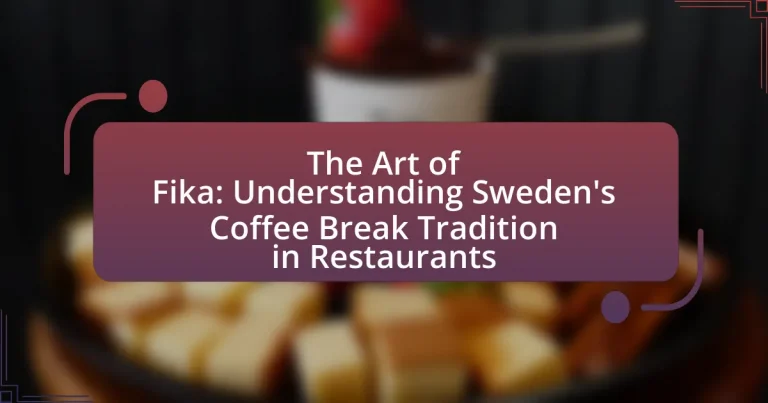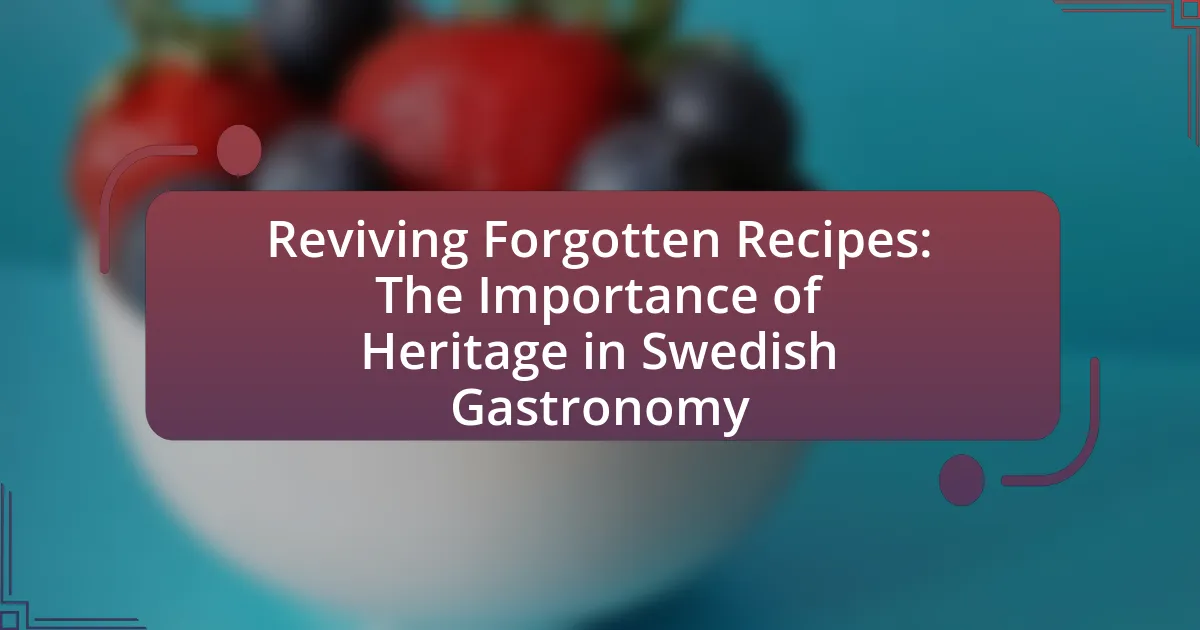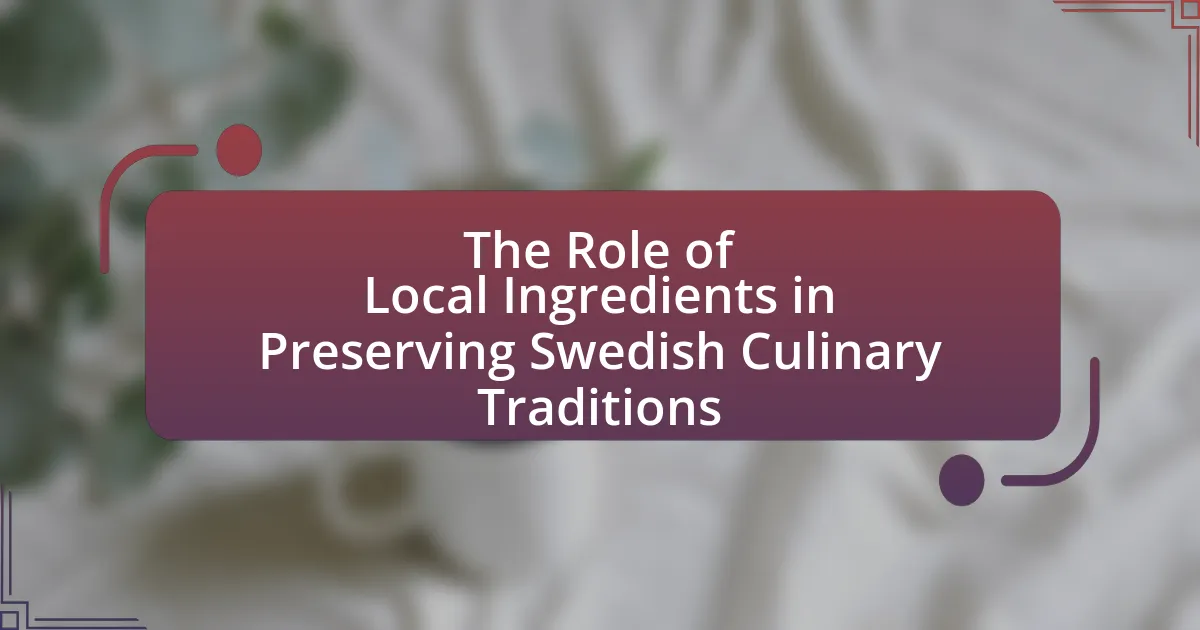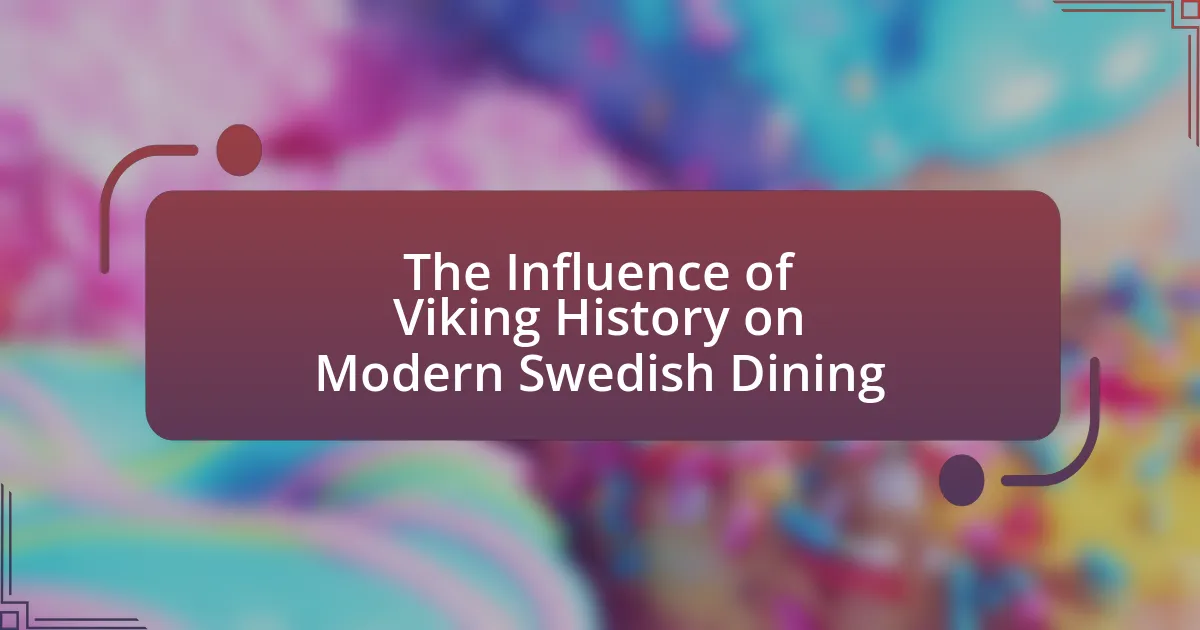The Art of Fika is a significant Swedish tradition centered around taking a break to enjoy coffee and pastries, promoting social interaction and relaxation. Originating in the 18th century, Fika has evolved into a cultural ritual that enhances workplace productivity and well-being by fostering community connections. The article explores the historical roots of Fika, its social benefits, and its role in modern workplace culture, as well as how restaurants incorporate this practice into their dining experiences. Additionally, it addresses the challenges Fika faces in contemporary society and offers tips for creating authentic Fika experiences at home or in restaurants.
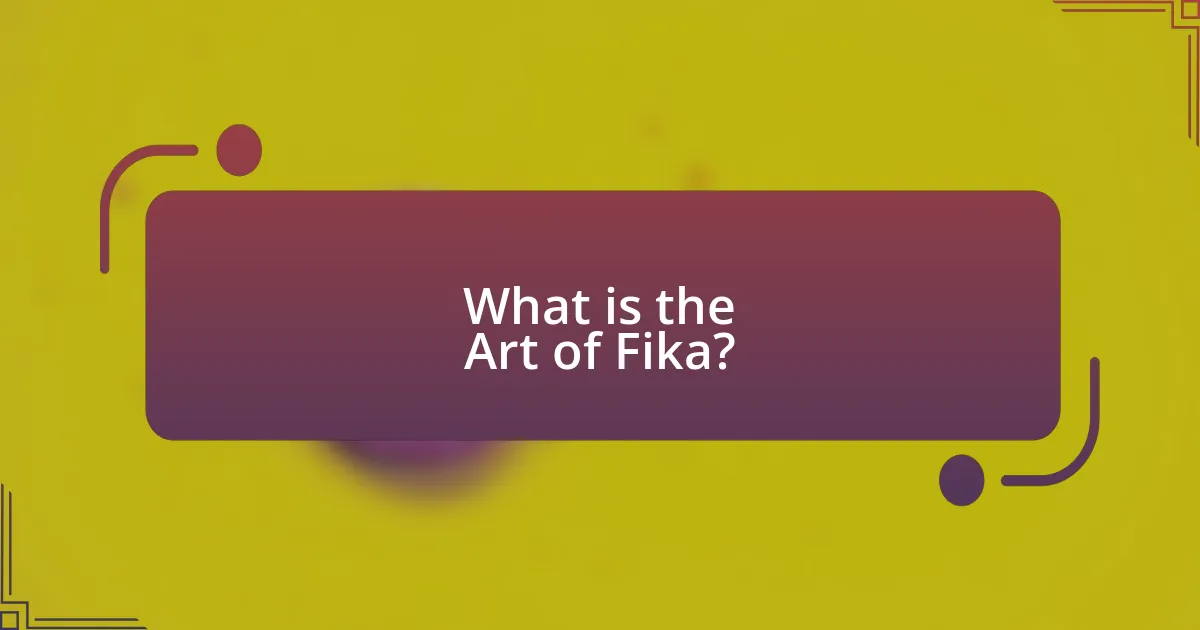
What is the Art of Fika?
The Art of Fika is a Swedish tradition that emphasizes taking a break to enjoy coffee and pastries, fostering social interaction and relaxation. This practice is not merely about consuming food and drink; it serves as a cultural ritual that encourages people to pause and connect with others, often in a cozy setting. Fika is deeply ingrained in Swedish society, with studies indicating that it enhances workplace productivity and employee well-being by promoting a balanced work-life dynamic.
How did the tradition of Fika originate in Sweden?
The tradition of Fika originated in Sweden during the 18th century as a coffee break ritual. Initially, it began as a way for people to enjoy coffee, which was a luxury item at the time, often accompanied by pastries or baked goods. The term “Fika” itself is derived from a reversal of the syllables in the word “kaffi,” which means coffee in Swedish. Over time, Fika evolved into a social institution, emphasizing the importance of taking a break to connect with others, whether at home, work, or in cafes. This cultural practice is now deeply embedded in Swedish society, reflecting values of community and relaxation.
What historical events influenced the development of Fika?
The development of Fika in Sweden was influenced by several historical events, particularly the introduction of coffee in the 17th century and the subsequent coffeehouse culture that emerged in the 18th century. Coffee was initially met with resistance due to concerns about its effects, but by the 18th century, it became widely accepted and popularized, leading to the establishment of coffeehouses as social hubs. These venues fostered community interaction and laid the groundwork for the modern Fika tradition, which emphasizes taking a break to enjoy coffee and pastries in a social setting. The cultural significance of Fika was further solidified in the 20th century as it became a staple in Swedish workplaces, reflecting the country’s values of work-life balance and social connection.
How has Fika evolved over the years?
Fika has evolved from a simple coffee break into a significant cultural practice in Sweden, emphasizing social interaction and community. Initially, Fika was primarily a time for coffee consumption, but over the years, it has incorporated a variety of pastries and snacks, reflecting Sweden’s culinary traditions. The practice has also expanded beyond the home to workplaces and public spaces, becoming a vital part of Swedish social life and business culture. This evolution is supported by the increasing popularity of coffee shops and cafes in Sweden, where Fika is celebrated as a moment to pause and connect with others, highlighting its importance in fostering relationships and enhancing well-being.
Why is Fika considered an important cultural practice in Sweden?
Fika is considered an important cultural practice in Sweden because it fosters social connections and promotes well-being among individuals. This tradition involves taking a break to enjoy coffee and pastries, allowing people to pause their daily activities and engage in meaningful conversations. Research indicates that such social interactions can enhance mental health and workplace productivity, making Fika not just a leisurely activity but a vital aspect of Swedish culture that emphasizes community and balance in life.
What social benefits does Fika provide to individuals and communities?
Fika provides significant social benefits to individuals and communities by fostering social connections and enhancing mental well-being. This Swedish coffee break tradition encourages people to take time out of their busy schedules to engage in meaningful conversations, which strengthens relationships and builds community ties. Research indicates that social interactions during Fika can reduce stress and improve overall happiness, as individuals feel more connected and supported. Additionally, Fika promotes inclusivity by bringing together diverse groups, allowing for the exchange of ideas and cultural experiences, which enriches community life.
How does Fika contribute to workplace culture in Sweden?
Fika significantly enhances workplace culture in Sweden by fostering social connections and promoting a balanced work-life environment. This traditional coffee break encourages employees to step away from their tasks, engage in informal conversations, and build relationships, which can lead to improved teamwork and collaboration. Research indicates that such social interactions during breaks can increase job satisfaction and productivity, as employees feel more connected and valued within their workplace. Additionally, Fika embodies the Swedish value of egalitarianism, as it provides an opportunity for all employees, regardless of rank, to participate equally in discussions, thereby strengthening workplace cohesion.
What are the key components of a traditional Fika experience?
A traditional Fika experience consists of coffee, pastries, and social interaction. Coffee is typically served strong and can be accompanied by a variety of baked goods, such as cinnamon buns or cookies. The social aspect emphasizes taking a break from work or daily activities to connect with friends, family, or colleagues, fostering a sense of community. This practice is deeply rooted in Swedish culture, where Fika is not just about the food and drink but also about the importance of pausing to enjoy life and build relationships.
What types of food and beverages are typically served during Fika?
During Fika, traditional Swedish coffee breaks, coffee is the primary beverage served, often accompanied by a variety of pastries and baked goods. Common food items include cinnamon buns (kanelbullar), cardamom buns (kardemummabullar), and various cakes such as princess cake (prinsesstårta) and chocolate cake (chokladtårta). These selections reflect Sweden’s rich baking culture and the importance of social interaction during Fika, which is a cherished tradition in Swedish society.
How does the setting influence the Fika experience?
The setting significantly influences the Fika experience by creating an atmosphere conducive to relaxation and social interaction. In Sweden, Fika is traditionally enjoyed in cozy, inviting spaces such as cafes or homes, where comfortable seating and warm lighting encourage people to linger and engage in conversation. Research indicates that environments with natural elements, like plants or views of nature, enhance well-being and promote a sense of calm, which aligns with the Fika’s purpose of taking a break from daily stress. Additionally, the presence of baked goods and coffee in a visually appealing setting can stimulate the senses, making the experience more enjoyable and memorable.
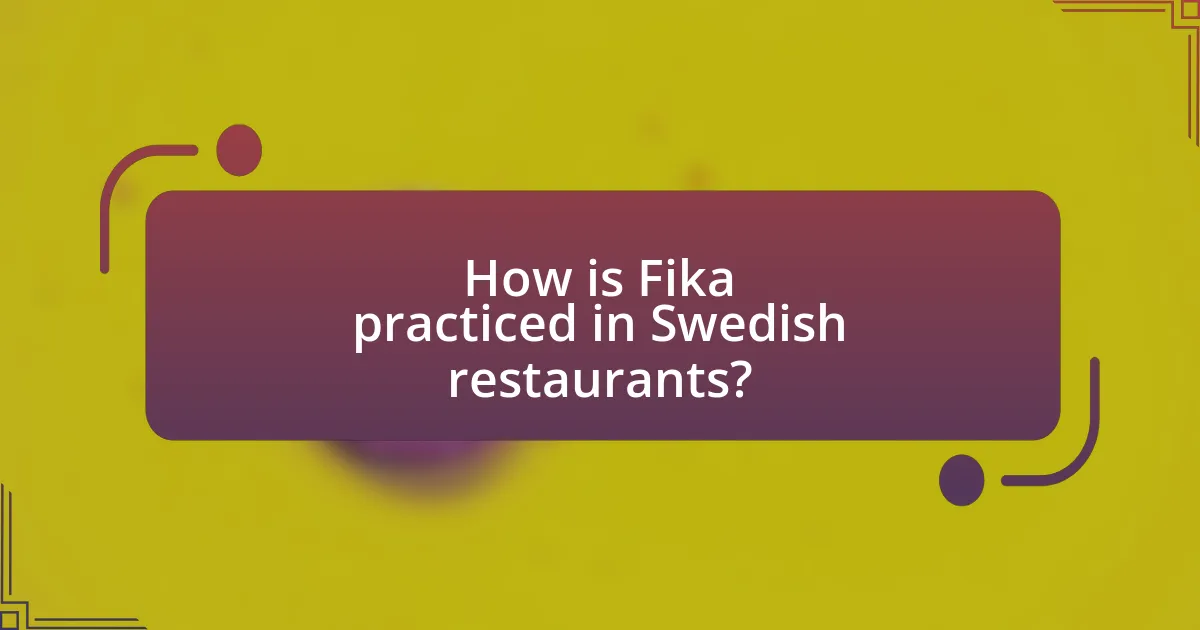
How is Fika practiced in Swedish restaurants?
Fika is practiced in Swedish restaurants as a designated coffee break where patrons enjoy coffee alongside pastries or light snacks. This tradition emphasizes social interaction and relaxation, often occurring mid-morning or mid-afternoon. Restaurants typically offer a variety of coffee options and traditional Swedish pastries, such as cinnamon buns or cardamom bread, to enhance the experience. The practice is rooted in Swedish culture, promoting a balance between work and leisure, and is recognized as an essential part of daily life in Sweden.
What role do restaurants play in the Fika tradition?
Restaurants serve as essential venues for the Fika tradition, providing a social space where individuals can gather to enjoy coffee and pastries. In Sweden, Fika is not just about the food; it emphasizes connection and conversation, making restaurants ideal settings for this cultural practice. Many restaurants offer specialized Fika menus featuring traditional items like cinnamon buns and cardamom bread, which enhance the experience. Additionally, the ambiance of restaurants fosters a relaxed environment conducive to the leisurely pace of Fika, allowing patrons to take a break from their daily routines and engage in meaningful interactions.
How do restaurants create an inviting atmosphere for Fika?
Restaurants create an inviting atmosphere for Fika by incorporating cozy seating arrangements, warm lighting, and a relaxed ambiance. These elements encourage patrons to linger and enjoy their coffee and pastries, aligning with the Fika tradition of taking a break to socialize. Additionally, many restaurants feature Swedish decor and serve traditional Fika items, such as cinnamon buns and coffee, which enhance the cultural experience. Research indicates that environments designed for comfort and social interaction significantly improve customer satisfaction, making the Fika experience more enjoyable.
What menu items are popular for Fika in restaurants?
Popular menu items for Fika in restaurants include coffee, cinnamon buns, and various pastries. Coffee is typically served as a strong brew, often accompanied by sweet treats like kanelbullar (cinnamon buns), which are a staple in Swedish culture. Other common items include cardamom buns, cookies, and cakes, such as the classic Prinsesstårta (Princess Cake). These items reflect the traditional Swedish approach to Fika, emphasizing a balance of rich flavors and comforting textures, making the experience both enjoyable and social.
How do restaurants promote the Fika experience to customers?
Restaurants promote the Fika experience to customers by creating a welcoming atmosphere that encourages relaxation and social interaction. They often design cozy seating arrangements and offer a menu featuring traditional Swedish pastries, such as cinnamon buns and cardamom bread, paired with high-quality coffee or tea. Additionally, many establishments host Fika-themed events or workshops to educate patrons about the cultural significance of this coffee break tradition. Research indicates that the Fika experience enhances customer satisfaction and loyalty, as it aligns with the growing trend of mindfulness and slow living in dining experiences.
What marketing strategies are effective for promoting Fika in restaurants?
Effective marketing strategies for promoting Fika in restaurants include creating themed events, leveraging social media, and offering special Fika menus. Themed events, such as Fika afternoons or Swedish cultural nights, attract customers by providing an immersive experience that highlights the tradition. Social media campaigns showcasing visually appealing Fika setups can engage potential customers and encourage sharing, increasing visibility. Additionally, offering a dedicated Fika menu featuring traditional pastries and coffee can entice patrons to experience this cultural practice, as evidenced by the growing popularity of Fika in various urban areas, where restaurants report increased foot traffic and customer interest in Swedish cuisine.
How do restaurants incorporate Fika into their overall dining experience?
Restaurants incorporate Fika into their overall dining experience by offering designated times for coffee breaks paired with pastries, creating a relaxed atmosphere that encourages social interaction. This practice aligns with the Swedish tradition of taking a break to enjoy coffee and sweets, often featuring items like cinnamon buns or cardamom bread. By integrating Fika into their service model, restaurants enhance customer satisfaction and promote a sense of community, which is supported by studies showing that social dining experiences can lead to increased customer loyalty and repeat visits.
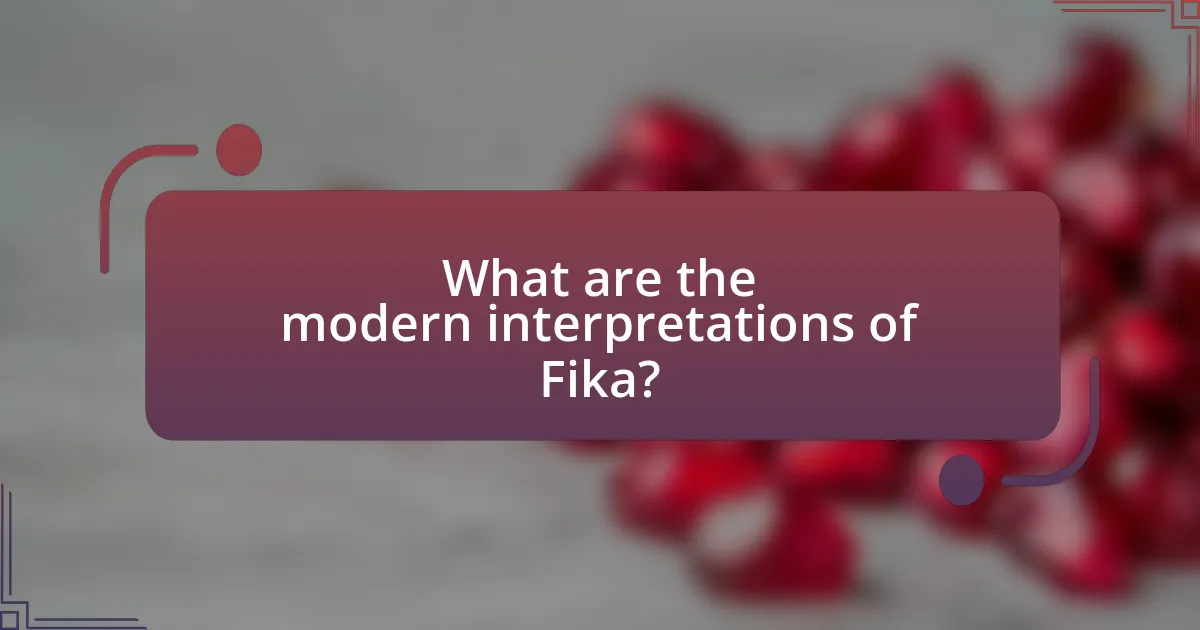
What are the modern interpretations of Fika?
Modern interpretations of Fika emphasize its role as a social and cultural practice rather than merely a coffee break. In contemporary settings, Fika is often seen as an opportunity for connection, collaboration, and mindfulness, encouraging individuals to pause and engage in meaningful conversations. This shift reflects a broader trend towards work-life balance and mental well-being, with many workplaces adopting Fika as a formal practice to enhance employee morale and productivity. Research indicates that such breaks can improve focus and creativity, aligning with the principles of Fika as a restorative ritual.
How has globalization affected the practice of Fika?
Globalization has expanded the practice of Fika beyond Sweden, introducing it to international audiences and altering its traditional elements. As Swedish culture has gained global recognition, coffee shops worldwide have adopted Fika-inspired breaks, often incorporating local pastries and beverages, which diversifies the experience. This adaptation reflects a blend of cultural exchange, where the essence of Fika—social connection and relaxation—remains, but the specifics of the practice evolve to fit different cultural contexts. For instance, in urban centers like New York and London, Fika is marketed as a unique social experience, attracting diverse clientele and promoting a slower pace in fast-paced environments.
What adaptations have been made to Fika in non-Swedish contexts?
Fika has been adapted in non-Swedish contexts by incorporating local customs, varying food offerings, and adjusting the duration of the break. For instance, in the United States, Fika often includes a wider variety of pastries and coffee styles, reflecting local preferences, while in Australia, it may blend with the café culture, emphasizing artisanal coffee and brunch items. These adaptations maintain the essence of social interaction and relaxation but cater to regional tastes and practices, demonstrating the flexibility of the Fika concept across different cultures.
How do modern cafes and restaurants innovate traditional Fika offerings?
Modern cafes and restaurants innovate traditional Fika offerings by incorporating diverse flavors, contemporary presentation styles, and unique pairings with specialty coffees and teas. For instance, many establishments now offer gluten-free or vegan versions of classic Swedish pastries like kanelbullar (cinnamon buns) to cater to dietary preferences, reflecting a broader trend towards inclusivity in food options. Additionally, some cafes experiment with fusion desserts that blend traditional Swedish elements with international influences, such as matcha-infused pastries or cardamom-spiced cakes. This innovation not only enhances the traditional Fika experience but also attracts a wider audience, as evidenced by the increasing popularity of cafes that emphasize artisanal and locally sourced ingredients, which aligns with consumer demand for quality and sustainability in dining experiences.
What challenges does the Fika tradition face today?
The Fika tradition faces challenges such as the increasing pace of modern life and the rise of remote work. As people become busier and more focused on productivity, the opportunity to take a leisurely coffee break diminishes. Additionally, remote work reduces the communal aspect of Fika, as individuals may not engage in this social ritual with colleagues. According to a study by the Swedish Institute, the cultural significance of Fika is at risk as younger generations prioritize efficiency over tradition, leading to a decline in its practice.
How do changing lifestyles impact the practice of Fika?
Changing lifestyles significantly impact the practice of Fika by altering the frequency and context in which this coffee break tradition is observed. As modern work environments increasingly embrace remote work and flexible schedules, traditional Fika moments, often associated with office culture, are becoming less common. A study by the Swedish Institute indicates that 40% of Swedes now work remotely at least part-time, leading to a decline in communal coffee breaks that foster social interaction. Additionally, the fast-paced nature of contemporary life, characterized by a focus on productivity and efficiency, diminishes the time allocated for leisurely breaks, which are essential to the Fika experience. This shift results in a more fragmented practice of Fika, where individuals may still enjoy coffee but miss the communal and social aspects that define the tradition.
What can be done to preserve the essence of Fika in contemporary society?
To preserve the essence of Fika in contemporary society, individuals and businesses should prioritize creating dedicated spaces for social interaction and relaxation. Establishing cozy environments in cafes and workplaces that encourage people to take breaks together fosters the communal aspect of Fika. Research indicates that social connections enhance well-being, which aligns with Fika’s purpose of promoting relationships over coffee and pastries. Additionally, offering traditional Swedish pastries and coffee options can maintain authenticity, as these elements are central to the Fika experience. By integrating these practices, society can uphold the cultural significance of Fika while adapting to modern lifestyles.
What are some tips for enjoying Fika at home or in restaurants?
To enjoy Fika at home or in restaurants, prioritize a cozy atmosphere with comfortable seating and good lighting. This enhances the experience, as Fika is about relaxation and connection. Pair quality coffee with traditional Swedish pastries like cinnamon buns or cardamom bread, which are essential to the Fika experience. Engage in meaningful conversation, as Fika is a social ritual meant to foster relationships. Additionally, take your time; the essence of Fika lies in savoring both the food and the moment, rather than rushing through it.
How can one create an authentic Fika experience at home?
To create an authentic Fika experience at home, one should focus on serving high-quality coffee alongside traditional Swedish pastries, such as cinnamon buns or cardamom rolls. This practice reflects the essence of Fika, which emphasizes taking a break to enjoy good food and conversation. The coffee should ideally be brewed using a method that highlights its flavor, such as a French press or pour-over, and the pastries should be freshly baked or sourced from a reputable bakery to ensure authenticity. Additionally, setting a cozy atmosphere with comfortable seating and inviting decor can enhance the experience, making it conducive to relaxation and social interaction, which are key components of Fika culture in Sweden.
What are the best practices for hosting a Fika gathering?
The best practices for hosting a Fika gathering include creating a welcoming atmosphere, offering a variety of coffee and baked goods, and encouraging social interaction among guests. A welcoming atmosphere can be achieved through comfortable seating and a relaxed environment, which fosters conversation. Providing a selection of traditional Swedish pastries, such as cinnamon buns and cardamom bread, alongside quality coffee enhances the experience. Encouraging guests to engage in meaningful conversations is essential, as Fika is not just about food and drink but also about building relationships and enjoying each other’s company. These practices align with the cultural significance of Fika in Sweden, where it serves as a vital social ritual that promotes community and connection.
